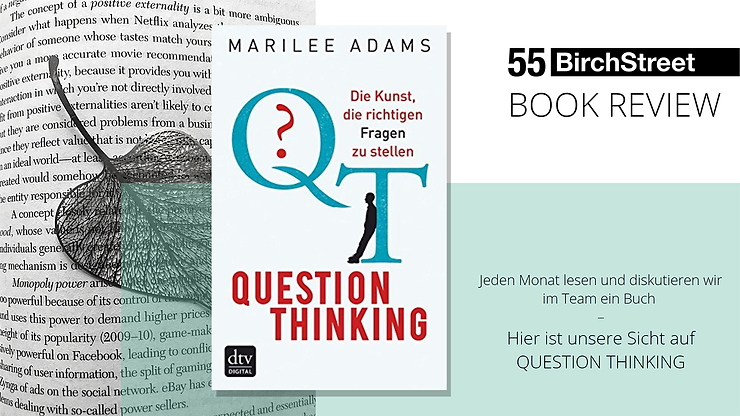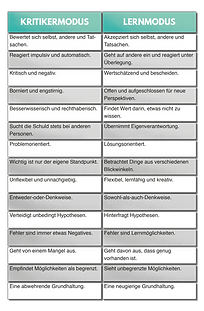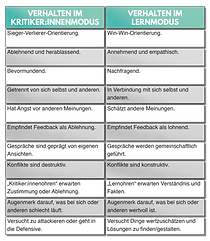
“You idiot, go! “— Does it sound familiar to you? No, it's not about the book “Surrounded By Idiots” (spoiler, this will be our next book review!) , but about the “critic mode” called by Marilee Adams, which stands in contrast to “learning mode.” Whether professionally or privately, we often allow ourselves to be tempted into automatic reactions that are not really solution-oriented. Just think back briefly to your last reaction when you were honked in traffic. Oops!
In the book”Question Thinking — The art of asking the right questions” Adams presents her Choice Map principle to us. With the help of supposedly realistic characters and example situations, she illustrates that we always have the choice of how we want to behave and what can be helpful in navigating frustrating situations correctly.
In summary, the principle of the book: There are two different modes, which represent a respective stance: The critic mode (okay, the gender comes from us) and the learning mode. Both are on the so-called Choice Map, so we always have the choice of which mode we use in communication and problem solving. The challenge with which Adams wants to support readers: How do I get on the learning path through which I can create win-win situations in a well-thought-out, solution-oriented and cooperative manner, instead of sinking into the critics' swamp due to sheer frustration?
Adams communicates her messages and the underlying question-thinking method about the personal story of a fictitious — based on reality yet far missed — main character named Ben and his teacher. Ben starts out as a judgmental critic who is not necessarily open to the opinions of others, because he knows better anyway, and the teacher... well... just proves him wrong in order to consistently equip Ben adequately for work and everyday life. A bit like Karate Kid, but unfortunately without karate.
By the way, according to Adams, a very wonderful question in “learning mode” — good job!
You might think that such a story sounds very dogmatic and prefabricated, with Ben and the teacher as a fairly simple parable for a comprehensible presentation. Unfortunately it is also correct. But in the same book, we learned to be able to decide to learn something. Well then: What are the facts?
Through simple picture book dialogues and repetitive messages on relatively few pages, the book provides all interested readers of all levels of maturity with a tool. We are then responsible for the use. And that's probably the crux of the matter.
Be it a principle, a method or an “art” — asking yourself appropriate questions in order to show your best possible behavior when dealing with others requires incorporating this into your mindset. It takes time and practice. Who succeeds in not immediately asking “whose fault it is” the next time they honk, but “What am I responsible for? “We personally congratulate him.

Despite this American “narrative style”, the redundancy of the statements (the sentence “we are all critics in therapy” was used at least four times) and sometimes old-fashioned attitudes of the characters — oh wait, now we've ended up in critic mode again!
From the beginning: With the help of the learning mode vs. critic mode tables in particular, the book manages to make it clear how these mindsets differ. Every reader will certainly find himself in it and can evoke situations from memory in which you could observe this behavior live and in color —

whether with yourself or with others. Question Thinking is in favour of normalizing this state of our “critical attitude” and acknowledging it as part of ourselves. We won't be able to turn him off because he is human. Instead, it is about learning to recognize him and to be able to actively decide when we want to act in which mode. An ability to reflect that we find extremely valuable!
In terms of content, all of this is very easy to digest. The writing style is simple and understandable (which admittedly not everyone in the team liked stylistically) and Adams presents her ideas and theory adequately, even though she sometimes gets lost in self-help jargon.
The team had different impressions of the book — but everyone had insights that we could use to further improve our conflict resolution skills! For example, one of our biggest takeaways is that the way we think has a direct influence on the questions we ask and that in turn could be important for the things we want to shed light on in direct customer conversations, for an even more constructive exchange.
Our relationship with criticism is also more reflected as a result. As is well known, criticism is not consistently bad, but sometimes bad, we take a statement as an affront. With her concept of critic mode (albeit perhaps unintentionally), Adams promotes an important distinction between the content of criticism and a negative attitude of criticism, in which the aim is not to address justified mistakes, but the consistent rejection of everything. Ergo: Critical questioning, of course! General criticism, rather less so.
As consultants in particular, you sometimes fall into focusing only on what is not yet running instead of focusing on things that work well. In general, thanks to the discussion surrounding the book, we hope to be even more aware in learning mode.

Stephen: The book has given me a bunch of colorful ideas that I will continue to think about. While reading, I have already thought about a lot of things that still concern me.

anne: Question Thinking has definitely freed me up in my head. Since then, various practical situations have also been easier to explain to me.

lena: If all of the content was correct, it would certainly have been possible to write it on fewer pages. The content is correct, stylistically difficult.
The shelves of self-help guides and specialist and non-fiction books are overflowing with help to ask the right questions. A demanding task, especially when, how and which question is effective and yet still authentic, instead of a toolbox of methods on two legs. Question Thinking is certainly not the first and not the best of these self-coaching books, and yet it is an important reminder: Especially in critical situations or exhausting discussions, it helps to observe and question yourself from outside: “Is my behavior just leading to the desired result? “And if not, how can I maybe get back onto the productive, constructive learning path? Whether this book is needed for that is a matter of opinion. We are looking forward to your feedback!
Du hast eine Frage oder möchtest herausfinden, wie wir zusammenarbeiten können?
Melde dich gerne hier oder über LinkedIn bei uns – wir freuen uns, von dir zu hören